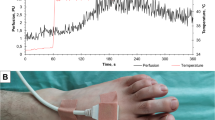Abstract
Laser speckle flowgraphy (LSFG) is a new device that can measure skin blood flow and capture the movement of erythrocytes. However, there are a few reports on the use of LSFG to estimate skin blood flow, especially in the lower extremities. We aimed to compare plantar skin blood flow between patients with and without peripheral arterial disease (PAD) to discern the extent to which LSFG could accurately predict PAD. We prospectively measured the plantar skin blood flow in 28 patients with PAD and 37 participants without PAD at two hospitals from 2017 to 2021, using the ankle–brachial index (ABI) and LSFG. We partitioned the plantar into 12 parts: digits 1–5, medial metatarsal, middle metatarsal, lateral metatarsal, medial arch, middle arch, lateral arch, and heel, and compared the difference between the two groups and the area under the curve (AUC) of each point. Statistical analyses were performed to determine the sensitivity, specificity, false-positive rate, and false-negative rate at high accuracy points of AUC and ABI. There was a significant difference among the 12 points between the two groups, and the ratio using toe 1 and toe 5 was highly accurate. The ratio using toe 1 indicated higher sensitivity (89 vs. 82%), higher false-positive rate (22 vs. 4%), lower specificity (81 vs. 97%), and an equivalent false-negative rate (9 vs. 12%) to that of the ABI. These findings could facilitate the use of LSFG to estimate the skin blood flow condition in the plantar skin. Our results indicate that measuring toe 1 using LSFG could be used to somewhat assess PAD.





Similar content being viewed by others
References
Kikuchi S, Miyake K, Tada Y, Tada Y, Uchida D, Koya A, Saito Y, Ohura T, Azuma N (2019) Laser speckle flowgraphy can also be used to show dynamic changes in the blood flow of the skin of the foot after surgical revascularization. Vascular 27:242–251
Nakagami G, Sari Y, Nagase T, Iizaka S, Ohta Y, Sanada H (2010) Evaluation of the usefulness of skin blood flow measurements by laser speckle flowgraphy in pressure-induced ischemic wounds in rats. Ann Plast Surg 64:351–354
Nagashima Y, Ohsugi Y, Niki Y, Maeda K, Okamoto T (2015) Assessment of laser speckle flowgraphy: Development of novel cutaneous blood flow measurement technique. Proc SPIE 9792, Biophotonics Japan 979218. https://doi.org/10.1117/12.2203712
Fujii H, Okamoto K, Le PT, Takahashi N, Shirakawa T, Kuroki T (2018) Blood flow dynamic imaging diagnosis device and diagnosis method. JP pat. WO2018/003139
Tsunekawa K, Nagai F, Kato T, Takashimizu I, Yanagisawa D, Yuzuriha S (2021) Hallucal thenar index: A new index to detect peripheral arterial disease using laser speckle flowgraphy. Vascular 29:100–107. https://doi.org/10.1177/1708538120938935
Katsuki T, Yamaji K, Tomoi Y, Hiramori S, Soga Y, Ando K (2020) Clinical impact of improvement in the ankle–brachial index after endovascular therapy for peripheral arterial disease. Heart Vessels 35:177–186
Królczyk J, Skalska A, Piotrowicz K, Mossakowska M, Grodzicki T, Gąsowski J (2021) Disparate effects of ankle–brachial index on mortality in the ‘very old’ and ‘younger old’ populations-the PolSenior survey. Heart Vessels. https://doi.org/10.1007/s00380-021-01949-1
De Clercq D, Aerts P, Kunnen M (1994) The mechanical characteristics of the human heel pad during foot strike in running: an in vivo cineradiographic study. J Biomech 27:1213–1222
Jahss M, Kummer F, Michelson J (1992) Investigations into the fat pads of the sole of the foot: heel pressure studies. Foot Ankle 13:227–232
Pai S, Ledoux WR (2010) The compressive mechanical properties of diabetic and non-diabetic plantar soft tissue. J Biomech 43:1754–1760
Pai S, Ledoux WR (2011) The quasi-linear viscoelastic properties of diabetic and non-diabetic plantar soft tissue. Ann Biomed Eng 39:1517–1527
Pai S, Ledoux WR (2012) The shear mechanical properties of diabetic and non-diabetic plantar soft tissue. J Biomech 45:365–370
Wang Y-N, Lee K, Ledoux WR (2011) Histomorphological evaluation of diabetic and non-diabetic plantar soft tissue. Foot Ankle Int 32:802–810
Norgren L, Hiatt W, Dormandy J, Nehler M, Harris K, Fowkes F, TASCII Working Group (2007) Inter-society consensus for the management of peripheral arterial disease (TASC II). J Vasc Surg 45:S5–S67
Fowkes F, Rudan D, Rudan I, Aboyans V, Denenberg J, McDermott M, Norman P, Sampson U, Williams L, Mensah G, Criqui M (2013) Comparison of global estimates of prevalence and risk factors for peripheral artery disease in 2000 and 2010: a systematic review and analysis. Lancet 382:1329–1340
Armstrong D, Lavery L (1998) Diabetic foot ulcers: prevention, diagnosis and classification. Am Fam Physician 57:1325–1332
Acknowledgements
The authors would like to thank the participants for their involvement in this study.
Funding
The authors received no financial support for the research, authorship, and/or publication of this article.
Author information
Authors and Affiliations
Corresponding author
Ethics declarations
Conflict of interest
The authors declare no potential conflicts of interest with respect to this research, authorship, and/or publication of this article.
Consent to participate
Informed consent was obtained from all individual participants included in this study.
Consent to publish
Patients signed informed consent regarding publishing their data and photographs.
Additional information
Publisher's Note
Springer Nature remains neutral with regard to jurisdictional claims in published maps and institutional affiliations.
Rights and permissions
About this article
Cite this article
Tsunekawa, K., Kato, T., Ebisawa, S. et al. Which plantar region can predict peripheral arterial disease by using laser speckleflowgraphy?. Heart Vessels 37, 738–744 (2022). https://doi.org/10.1007/s00380-021-01985-x
Received:
Accepted:
Published:
Issue Date:
DOI: https://doi.org/10.1007/s00380-021-01985-x




